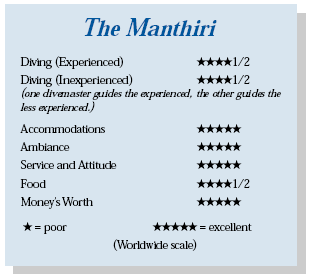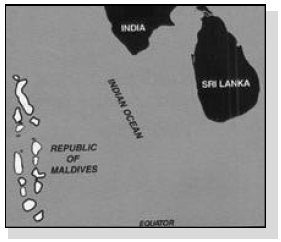The Maldives Aboard the ManthiriContents of this Issue: America’s Caribbean Island: Navassa Navy SEALS Strap on Cochran Computers nearly 20 years after sport divers The Maldives Aboard the Manthiri Editorial Office: Ben Davison Publisher and Editor Undercurrent 3020 Bridgeway, Suite 102 Sausalito, CA 94965 great diving despite El Niño from the May, 2001 issue of Undercurrent
It was with some trepidation that I began my giant stride from the Manthiri dive tender. The last time I dived the Maldives was just before the 1998 El Niño that had caused massive coral bleaching. Undercurrent readers had reported the death of much of the hard coral. Anticipating my first dive for a 20-day trip, I hoped I was not going to be visiting an underwater desert. Dropping down off the wall I was excited to see the familiar clouds of fish. But as I finned closer to the wall, I saw that indeed a lot of hard coral had died, perhaps as much as 90 percent. There lay piles of rubble that was once healthy Acropora branching coral. I was happy to see lots of healthy soft corals, gorgonia, tubastrea, and a profusion of mushroom corals everywhere -- and the buds of new hard coral growth. I didn’t see any ‘bleached’ coral -- that which bleached had died. One encouraging sign was the number of tridacna clams. Since they, like the corals, need zooanthellae to survive, their condition indicated that at least part of the reef system is on the rebound. This was NOT the Maldives I visited three times before -- still excellent diving, considering the wealth of fish life of all descriptions on every dive, which seldom exceeded 100 feet. The turtles were plentiful and unafraid. I often saw eagle, manta and stingrays. Eels were prolific. Drifting down the reef with a Napoleon wrasse bigger than a Saint Bernard is a thrill. Large trevally jacks, mackerel, and dogtooth tuna prowled the walls. At Deburi Tila -- Anemone City -- I dropped into a school of tuna, saw flying eagle rays, then spent most of the dive visiting with the anemones and the endemic black foot anemone fish that blanket the reef. At Angoli Caves, red-toothed triggerfish in the thousands stuck their forked tails out of holes as a massive cloud of bannerfish streamed over the reef near the end of the dive. The highlight here was the orchard of sea fans with resident longnosed hawkfish. The dives I enjoyed the most were at the reef channel fronts where white-tip and gray-reef sharks patrol. Ascending through the swirling fusiliers and snappers is a good way to end these sharky dives. On the reefs, varieties of butterfly fish, parrots, anthias, flame gobies, scorpionfish and lionfish provide photo opportunities as do the more elusive clown triggerfish. There were plenty of posing Oriental and spotted sweetlips. I saw many more sea cucumbers and starfish (though not the crown of thorns that was once a major problem) than on previous visits. I wonder if they flourish in an environment of recovering corals? I like the Maldives. I like the country. I like the people. And I like the diving. For more than 25 years I enjoyed the best reefs the world has to offer: Cocos, Galapagos, Papua New Guinea, Thailand, Solomons, Truk, and most of the Caribbean. Still, I keep returning to the wondrous waters of the Maldives. This necklace of almost 2,000 coral islands with blinding white-sand beaches, glistening green palm trees and underwater glories comes awfully close to an ideal vacation spot -- almost a New Yorker cartoon of the legendary “desert island.” The friendly people welcome tourists as a primary source of national revenue. There is no crime or rampant disease like malaria to concern visitors. The government is stable and riots that are a concern at destinations like Indonesia are almost unthinkable. On the dozens of tourist islands there are no buildings higher than a coconut palm and the government rule of one resort per island prevents the overcrowding that plagues so many places like Sipadan and Little Cayman. The people are followers of Islam, but are pragmatic so that they serve alcohol at resorts and on live-aboards. Sure, it’s a long way from Paducah, but so is Australia. There are several NonHughes/
Aggressor fleet live-aboards operating
around the world that have gained a major reputation among keen
divers. Meals are varied and the food plentiful. After a pre-breakfast of tea comes the first dive, then a breakfast of eggs, imitation bacon or ham, pancakes, peanut butter, jam, cheese, bananas, pineapple, mango, and papaya. Lunch consists of salad, soup, two main courses, perhaps fish and chicken or a pasta dish, fried potatoes or rice, followed by ice cream or a fresh fruit or a pastry. Dinner has complimentary wine, soup and a salad. Two choices -- usually a baked fish, perhaps a chicken curry, maybe a fried fish and a baked chicken -- and potatoes or rice. Dessert is fresh fruit or cake. No pork in this Muslim country. And as a fishing nation (and the crew does catch lots of fish) ... it seems to be their avocation, recreation and specialization, that there is going to be lots of fish on the menu. Like most liveaboards this is not a time to follow a low-fat, low-salt diet. The name of the game is diving. However, an entertainment center, stocked library, ice cream, plenty of hot water and frequent sheet and towel changes do not make a dive trip. What makes a dive trip is the dive operation. And here the Manthiri excels. Divemasters Manik and Moosa plan, brief, and lead the dives with keen enthusiasm (you may dive your computer, however). Captain Razaq, the tender driver, and his two assistants know these waters well and as divers themselves, enjoy treating visitors to the best spots. All diving is from a separate dive tender where tanks and gear are stored. Each diver has a roomy plastic bin for storage. The crew sets up tanks before dives. They provide bottled water. There are four entry points for 12 guests so crowding is minimal. One strong ladder forward is used to climb back on board. Clean, dry towels are provided as they rinse regulators. There are roomy fresh-water containers for photo/video gear that is carefully handled to and from the Manthiri. They fill the tanks from the compressor on the tender, so noise on the Manthiri is primarily from CDs brought by guests. Dive skins and suits are kept on the tender eliminating the reeking rubber often cluttering other livea boards . One thing to remember -- the Maldives does not provide ‘unlimited diving’ -- often promoted elsewhere. The most you can do from the Manthiri is four per day, and there are several three-dive days as the boat crosses to different atolls. And you won’t get a night dive every night. Still this boat provides more dives than any other operation in the Maldives. And the crew seems to enjoy providing other diversions like a picnic one night on a deserted island. There is a night at a local village listening to boderberu drum music and watching various ethnic “Fishermen Dances.” They provide walking tours of a resort island and a local village, and a shopping/sightseeing tour of Male at the end of the trip. Will I return? Certainly. And I won’t wait 10 years for the return of the hard corals. Life is short, the gods are capricious, El Niño is lurking, and I get more for my diving buck in the Maldives than almost anywhere else on this planet, even though some -- not all -- of the lush, hard coral, no longer remains. -- E.E. |

I want to get all the stories! Tell me how I can become an Undercurrent Online Member and get online access to all the articles of Undercurrent as well as thousands of first hand reports on dive operations world-wide
| Home | Online Members Area | My Account |
Login
|
Join
|
| Travel Index |
Dive Resort & Liveaboard Reviews
|
Featured Reports
|
Recent
Issues
|
Back Issues
|
|
Dive Gear
Index
|
Health/Safety Index
|
Environment & Misc.
Index
|
Seasonal Planner
|
Blogs
|
Free Articles
|
Book Picks
|
News
|
|
Special Offers
|
RSS
|
FAQ
|
About Us
|
Contact Us
|
Links
|
3020 Bridgeway, Ste 102, Sausalito, Ca 94965
All rights reserved.

 The Lammer Law in the Galapagos,
the Nai’a in Fiji, and the Bilikiki in the
Solomons come to mind. The Manthiri, which
has been operating in the Maldives for six
years, is another. Each time I visit, I
find improvements. It is air-conditioned
and spacious with roomy cabins and baths
for a maximum of 12 guests. The main salon
with its six overstuffed sofas is almost
like a clubroom albeit more often a
video/photographers/computer work area.
Especially noteworthy is the positive and
enthusiastic support of the crew. However,
I was disappointed at the number of roaches
that appeared during the latter part of
my trip, but was assured that major fumigation
is scheduled frequently. I guess I
caught a period before the slaughter.
The Lammer Law in the Galapagos,
the Nai’a in Fiji, and the Bilikiki in the
Solomons come to mind. The Manthiri, which
has been operating in the Maldives for six
years, is another. Each time I visit, I
find improvements. It is air-conditioned
and spacious with roomy cabins and baths
for a maximum of 12 guests. The main salon
with its six overstuffed sofas is almost
like a clubroom albeit more often a
video/photographers/computer work area.
Especially noteworthy is the positive and
enthusiastic support of the crew. However,
I was disappointed at the number of roaches
that appeared during the latter part of
my trip, but was assured that major fumigation
is scheduled frequently. I guess I
caught a period before the slaughter. Divers Compass: The Maldives
are 300 miles southwest of
India. The weather is warm with
cooling breezes, especially in
the evening. Prime diving is
November through April. More
rain and winds in June and
July. Whale sharks more frequently September through November ... More than 95
“safari boats” operate throughout the atolls. Comfort ranges from primitive to
five-star. There are 87 island resorts -- with comfort ranging from modest to fivestar.
Diving at almost all resorts and on almost all safari boats. Many resorts
cater to a particular European nationality so if your Italian, German or French is
barely adequate, search for a more user-friendly island via your travel agent or on
the net ... Flights from the U.S. via Singapore or through Europe on a number of
carriers. I flew three legs from East Coast via London and Dubai with no overnights
for $1,200 from a local travel agency. I saw much higher prices quoted on some
internet airfare sites ... Arrive a day early to sleep off the jet lag so as to
start diving refreshed. Economical hotel in Male: $60 at the Kam Hotel
(
Divers Compass: The Maldives
are 300 miles southwest of
India. The weather is warm with
cooling breezes, especially in
the evening. Prime diving is
November through April. More
rain and winds in June and
July. Whale sharks more frequently September through November ... More than 95
“safari boats” operate throughout the atolls. Comfort ranges from primitive to
five-star. There are 87 island resorts -- with comfort ranging from modest to fivestar.
Diving at almost all resorts and on almost all safari boats. Many resorts
cater to a particular European nationality so if your Italian, German or French is
barely adequate, search for a more user-friendly island via your travel agent or on
the net ... Flights from the U.S. via Singapore or through Europe on a number of
carriers. I flew three legs from East Coast via London and Dubai with no overnights
for $1,200 from a local travel agency. I saw much higher prices quoted on some
internet airfare sites ... Arrive a day early to sleep off the jet lag so as to
start diving refreshed. Economical hotel in Male: $60 at the Kam Hotel
( In Male you can pick up items like snacks unavailable at the
resorts. Internal flights from the international
airport are no longer on the old
Russian helicopter death traps. A fleet of
Twin Otter Seaplanes provides fast service.
Speedboats provide slower but cheaper
transfers ... You’ll need a passport. A
tourist visa good for 30 days is provided
on arrival. Book through Sea-N-See Pvt.
Ltd, Male Maldives. E-mail:
dhivehinet.net.mv. Web site:
In Male you can pick up items like snacks unavailable at the
resorts. Internal flights from the international
airport are no longer on the old
Russian helicopter death traps. A fleet of
Twin Otter Seaplanes provides fast service.
Speedboats provide slower but cheaper
transfers ... You’ll need a passport. A
tourist visa good for 30 days is provided
on arrival. Book through Sea-N-See Pvt.
Ltd, Male Maldives. E-mail:
dhivehinet.net.mv. Web site:
